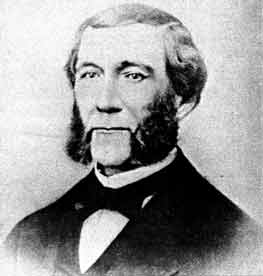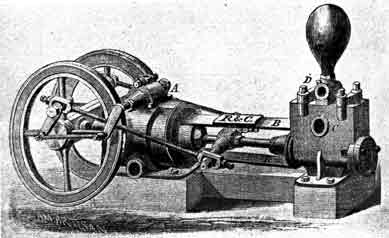 |
||||||
1865, The Van Syckel Pipeline
The year 1865 finally saw the pipeline gain a solid footing in the Pennsylvania oil region. The first major successful line was that of Samuel Van Syckel, an oil buyer and shipper in the Oil Creek area. Like previous pipeliners, Van Syckel was motivated by the often ruinously high prices charged by the teamsters to haul a wagon load of oil barrels to a distant or even nearby place which could be a refinery, a storage tank, a railroad yard, canal, a river bank (deep water), a city or to some other intermediate sales point. Unless a well was right on a navigable creek or river bank, teams and wagons were needed to move the laden barrels to a place of further shipment. There was a monopoly in overland transportation by this means. Teamsters, when they could, collected around $4 (or more) per barrel for long hauls and over a dollar per barrel for some relatively short hauls. The widely fluctuating price of crude oil couldn't support the teamster's haulage charges at all times, but the producers and the teamsters somehow weathered out the dips.
Pre-pipeline price swings in the first five years of the oil industry saw the price of crude oil fall to less than 10 cents a barrel while an empty new barrel could cost as much as $3.25. This imbalance, of course, brought production to a near standstill. Then the price rose via jagged ups and downs to a peak of over $12.00 (average) per barrel in 1864. The benefit of pipelines had not entered the picture yet, and the teamsters were able to continue charging high, sometimes capricious, rates.
The high rate for oil haulage from the wells in Oil Creek Valley wasn't the only factor that influenced Van Syckel. The Pithole field was discovered in 1865, lying some five miles southeast of Miller Farm station. It was in wilderness, no roads and difficult terrain. The teamsters soon priced themselves out of the picture for Pithole haulage and Van Syckel was eager to get that oil moving. His pipeline was the answer.
In 1865 Van Syckel laid about 5 miles of two-inch wrought iron pipe in 15 foot joints from Miller Farm RR Station on the west side of Oil Creek in a southeast direction to Pithole. This was in hilly terrain of about 400 feet relief, but over half of that was in the descent from the flanking ridge to Oil Creek. The joints cost $50 apiece and were tested to a pressure of 900 barrels to the square inch (Giddens, 1938). They were lap welded. William Snow was Van Syckel's engineer who determined the specifications of the pipe and the manner of laying it (Tait, 1946). Part of the pipeline was buried to two feet, and the rest was laid on top of the ground. Once it was in place, Van Syckel installed three Reed and Cogswell steam pumps, two of these at Pithole and the other nearby. These pumps pushed the oil at a rate of 81 barrels per hour to Miller Farm beginning October 10, 1865. About 1950 to 2000 barrels were arriving by the pipeline at the terminal daily, thus creating a need for more storage tanks. A fourth pump was installed at a later date at the Cherry Run crossing. This extra pump was estimated to increase the delivery of crude by 25 percent bringing the line's 24 hour delivery to 2500 barrels. Mechanical problems were minor and could be easily fixed. However, the teamsters were bent on damage and Van Syckel had to hire guards until the rampage was over.
This pipeline was the first successful one in the oil regions considering distance, topographical relief, pumps and rate of flow. It was a revolutionary means of transporting oil. It signaled the end of the teamsters' local monopoly and soon was followed by more pipelines laid hither and yon by a rash of newly formed companies. Van Syckel, seeing the gratifying remuneration of his pipeline (he charged $1.00 per barrel delivered to Miller Farm) laid another one practically parallel to it except that the terminal was at Meridith, a settlement on the east bank of Oil Creek directly opposite Miller Farm. The second line became operational on December 8, 1865.
The Van Syckel pipeline gave rise to a telegraph line along the same right-of-way (just as the railroads did). The telegraph was used to relay information on the complicated accounting of oil shipments since the pipelines were carrying crude from a lot of different producers and buyers. The telegraph could also signal emergencies letting one end know what those at the other end of the pipeline were doing in case of leakage or some other problem.
The following is quoted from the Oil Creek Valley and Pithole, Pennsylvania, Guidebook by S.T. Pees, 2001: "Van Syckel soon ran into bad luck even though his pipelines were doing well. He had two partners in the pipeline enterprise, both of whom failed financially for outside reasons, leaving Van Syckel in an awkward position because the lines (two of them) had not yet cleared all of their debts. The First National Bank of Titusville, under agreement with Van Syckel, operated the lines with the understanding that Van Syckel would regain ownership once the pipelines had earned enough to liquidate the debt (it was only $15,000). Van Syckel drifted away during this period, but the credit for the successful oil pipeline of any distance in the United States will always be his."
Samuel Van Syckel suffered plenty of reverses in his career, many of them happening after the pipeline, but while he was still in the oil region. These will not be recounted here. McLaurin in his Sketches in Crude Oil (1896) had the following to say about Van Syckel: "While often unsuccessful financially, earnest men like Samuel Van Syckel benefit mankind. The oil-business is much better for the fertile brain and perseverance of the man whose pipeline was the first to deliver oil to a railroad. His example stimulated other men combining keen perception and executive ability, who could sift the wheat from the chaff and discard the useless and impracticable."
|
||
|
![]()
| © 2004, Samuel T. Pees all rights reserved |
|

